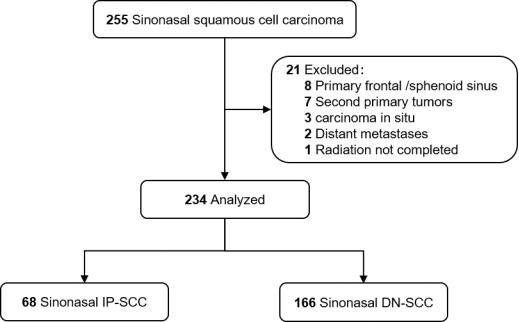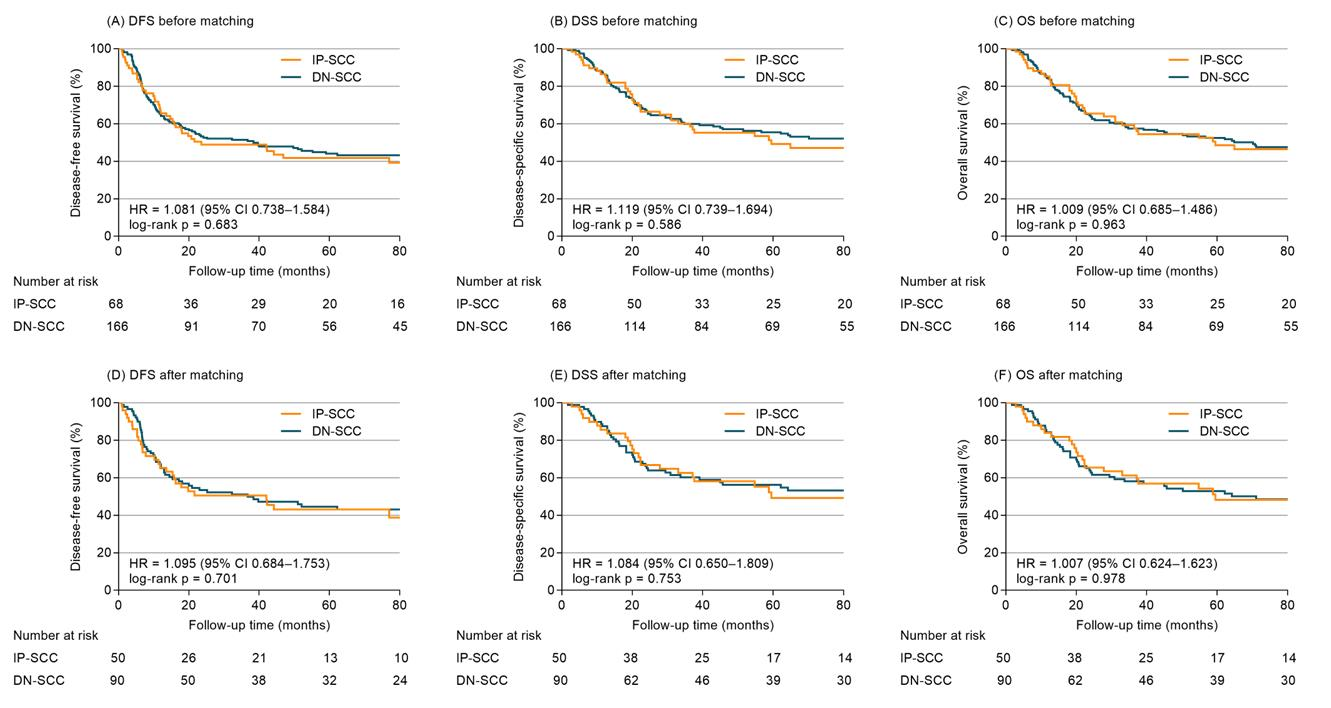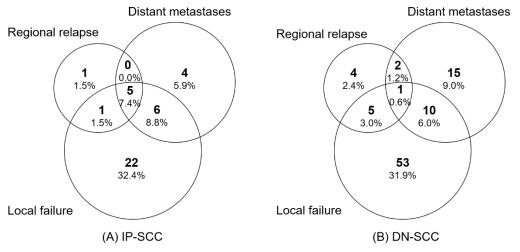Sinonasal Inverted Papilloma–Associated and De Novo Squamous Cell Carcinoma: A Tale of Two Cities or Not
Abstract
Simple Summary
Abstract
1. Introduction
2. Materials and Methods
2.1. Patient Identification
2.2. Treatment Planning
2.3. Statistical Analysis
3. Results
3.1. Comparison of Baseline Characteristics
3.2. Survival Outcomes of IP-SCC vs. DN-SCC
3.3. Comparison of Failure Patterns
4. Discussion
5. Conclusions
Supplementary Materials
Author Contributions
Funding
Institutional Review Board Statement
Informed Consent Statement
Data Availability Statement
Acknowledgments
Conflicts of Interest
References
- Silverberg, E.; Grant, R.N. Cancer statistics, 1970. CA Cancer J. Clin. 1970, 20, 11–23. [Google Scholar] [CrossRef] [PubMed]
- Taylor, M.A.; Saba, N.F. Cancer of the Paranasal Sinuses. Hematol. Oncol. Clin. N. Am. 2021, 35, 949–962. [Google Scholar] [CrossRef] [PubMed]
- Turner, J.H.; Reh, D.D. Incidence and survival in patients with sinonasal cancer: A historical analysis of population-based data. Head Neck 2012, 34, 877–885. [Google Scholar] [CrossRef]
- Sanghvi, S.; Khan, M.N.; Patel, N.R.; Yeldandi, S.; Baredes, S.; Eloy, J.A. Epidemiology of sinonasal squamous cell carcinoma: A comprehensive analysis of 4994 patients. Laryngoscope 2014, 124, 76–83. [Google Scholar] [CrossRef] [PubMed]
- Tanvetyanon, T.; Qin, D.; Padhya, T.; Kapoor, R.; McCaffrey, J.; Trotti, A. Survival outcomes of squamous cell carcinoma arising from sinonasal inverted papilloma: Report of 6 cases with systematic review and pooled analysis. Am. J. Otolaryngol. 2009, 30, 38–43. [Google Scholar] [CrossRef] [PubMed]
- Vrabec, D.P. The inverted Schneiderian papilloma: A 25-year study. Laryngoscope 1994, 104, 582–605. [Google Scholar] [CrossRef]
- Viitasalo, S.; Karhemo, P.R.; Vaananen, J.; Ilmarinen, T.; Lilja, M.; Katainen, R.; Monni, O.; Aaltonen, L.M. Exome sequencing reveals candidate mutations implicated in sinonasal carcinoma and malignant transformation of sinonasal inverted papilloma. Oral Oncol. 2022, 124, 105663. [Google Scholar] [CrossRef]
- Lawson, W.; Patel, Z.M. The evolution of management for inverted papilloma: An analysis of 200 cases. Otolaryngol. Head Neck Surg. 2009, 140, 330–335. [Google Scholar] [CrossRef]
- Miyazaki, T.; Haku, Y.; Yoshizawa, A.; Iwanaga, K.; Fujiwara, T.; Mizuta, M.; Yoshida, A.; Satou, S.; Tamaki, H. Clinical features of nasal and sinonasal inverted papilloma associated with malignancy. Auris Nasus Larynx 2018, 45, 1014–1019. [Google Scholar] [CrossRef]
- Bielamowicz, S.; Calcaterra, T.C.; Watson, D. Inverting papilloma of the head and neck: The UCLA update. Otolaryngol. Head Neck Surg. 1993, 109, 71–76. [Google Scholar] [CrossRef]
- Li, Y.; Wang, C.; Wang, R.; He, S.; Feng, L.; Ma, H.; Lian, M.; Shi, Q.; Zhong, Q.; Chen, X.; et al. Survival outcomes and prognostic factors of squamous cell carcinomas arising from sinonasal inverted papillomas: A retrospective analysis of 120 patients. Int. Forum Allergy Rhinol. 2019, 9, 1367–1373. [Google Scholar] [CrossRef] [PubMed]
- Mirza, S.; Bradley, P.J.; Acharya, A.; Stacey, M.; Jones, N.S. Sinonasal inverted papillomas: Recurrence, and synchronous and metachronous malignancy. J. Laryngol. Otol. 2007, 121, 857–864. [Google Scholar] [CrossRef] [PubMed]
- Lee, J.J.; Peterson, A.M.; Embry, T.W.; Wamkpah, N.S.; Kallogjeri, D.; Doering, M.M.; Schneider, J.S.; Klatt-Cromwell, C.N.; Pipkorn, P. Survival Outcomes of De Novo vs Inverted Papilloma-Associated Sinonasal Squamous Cell Carcinoma: A Systematic Review and Meta-analysis. JAMA Otolaryngol. Head Neck Surg. 2021, 147, 350–359. [Google Scholar] [CrossRef]
- Eide, J.G.; Welch, K.C.; Adappa, N.D.; Palmer, J.N.; Tong, C.C.L. Sinonasal Inverted Papilloma and Squamous Cell Carcinoma: Contemporary Management and Patient Outcomes. Cancers 2022, 14, 2195. [Google Scholar] [CrossRef] [PubMed]
- de Almeida, J.R.; Su, S.Y.; Koutourousiou, M.; Vaz Guimaraes Filho, F.; Fernandez Miranda, J.C.; Wang, E.W.; Gardner, P.A.; Snyderman, C.H. Endonasal endoscopic surgery for squamous cell carcinoma of the sinonasal cavities and skull base: Oncologic outcomes based on treatment strategy and tumor etiology. Head Neck 2015, 37, 1163–1169. [Google Scholar] [CrossRef]
- Lobo, B.C.; D’Anza, B.; Farlow, J.L.; Tang, D.; Woodard, T.D.; Ting, J.Y.; Sindwani, R. Outcomes of sinonasal squamous cell carcinoma with and without association of inverted papilloma: A multi-institutional analysis. Am. J. Rhinol. Allergy 2017, 31, 305–309. [Google Scholar] [CrossRef]
- Yan, C.H.; Newman, J.G.; Kennedy, D.W.; Palmer, J.N.; Adappa, N.D. Clinical outcomes of sinonasal squamous cell carcinomas based on tumor etiology. Int. Forum Allergy Rhinol. 2017, 7, 508–513. [Google Scholar] [CrossRef]
- Yu, M.S.; Lim, W.S.; Lee, B.J.; Chung, Y.S. Squamous cell carcinoma associated with inverted papilloma of the maxillary sinus: Our experience with 21 patients. Clin. Otolaryngol. Off. J. ENT-UK Off. J. Neth. Soc. Oto-Rhino-Laryngol. Cervico-Facial Surg. 2017, 42, 1048–1052. [Google Scholar] [CrossRef]
- Quan, H.; Zhang, H.; Zou, L.; Yuan, W.; Wang, S. Comparison of outcomes between patients with de-novo sinonasal squamous cell carcinoma vs malignant transformations from inverted papillomas. Int. Forum Allergy Rhinol. 2020, 10, 762–767. [Google Scholar] [CrossRef]
- Yasumatsu, R.; Jiromaru, R.; Hongo, T.; Uchi, R.; Wakasaki, T.; Matsuo, M.; Taura, M.; Nakagawa, T. A clinical analysis of sinonasal squamous cell carcinoma: A comparison of de novo squamous cell carcinoma and squamous cell carcinoma arising from inverted papilloma. Acta Otolaryngol. 2020, 140, 706–711. [Google Scholar] [CrossRef]
- Li, Y.; Wang, C.; Wang, R.; Zhang, J.; Liu, H.; Shi, Q.; Chen, X.; Hou, L.; Ma, H.; Zhong, Q.; et al. Prognostic Factors of Sinonasal Squamous Cell Carcinomas Arising De Novo and From Inverted Papilloma. Am. J. Rhinol. Allergy 2021, 35, 114–121. [Google Scholar] [CrossRef] [PubMed]
- Rubin, D.B. The design versus the analysis of observational studies for causal effects: Parallels with the design of randomized trials. Stat. Med. 2007, 26, 20–36. [Google Scholar] [CrossRef] [PubMed]
- Nudell, J.; Chiosea, S.; Thompson, L.D. Carcinoma ex-Schneiderian papilloma (malignant transformation): A clinicopathologic and immunophenotypic study of 20 cases combined with a comprehensive review of the literature. Head Neck Pathol. 2014, 8, 269–286. [Google Scholar] [CrossRef]
- Hess, K.R.; Serachitopol, D.M.; Brown, B.W. Hazard function estimators: A simulation study. Stat. Med. 1999, 18, 3075–3088. [Google Scholar] [CrossRef]
- Farrell, N.F.; Mace, J.C.; Detwiller, K.Y.; Li, R.; Andersen, P.E.; Smith, T.L.; Clayburgh, D.R.; Geltzeiler, M. Predictors of survival outcomes in sinonasal squamous cell carcinoma: An analysis of the National Cancer Database. Int. Forum Allergy Rhinol. 2021, 11, 1001–1011. [Google Scholar] [CrossRef]
- Quan, H.; Yan, L.; Zhang, H.; Zou, L.; Yuan, W.; Wang, S. Development and validation of a nomogram for prognosis of sinonasal squamous cell carcinoma. Int. Forum Allergy Rhinol. 2019, 9, 1030–1040. [Google Scholar] [CrossRef] [PubMed]
- Ansa, B.; Goodman, M.; Ward, K.; Kono, S.A.; Owonikoko, T.K.; Higgins, K.; Beitler, J.J.; Grist, W.; Wadsworth, T.; El-Deiry, M.; et al. Paranasal sinus squamous cell carcinoma incidence and survival based on Surveillance, Epidemiology, and End Results data, 1973 to 2009. Cancer 2013, 119, 2602–2610. [Google Scholar] [CrossRef]
- Yu, H.X.; Liu, G. Malignant transformation of sinonasal inverted papilloma: A retrospective analysis of 32 cases. Oncol. Lett. 2014, 8, 2637–2641. [Google Scholar] [CrossRef] [PubMed][Green Version]




| Characteristics | Entire Population | PSM Population | ||||
|---|---|---|---|---|---|---|
| IP-SCC N = 68 (%) | DN-SCC N = 166 (%) | p-Value | IP-SCC N = 50 (%) | DN-SCC N = 90 (%) | p-Value | |
| Age, years | ||||||
| ≤54 | 31 (45.6) | 88 (53.0) | 0.302 | 24 (48.0) | 38 (42.2) | 0.510 |
| >54 | 37 (54.4) | 78 (47.0) | 26 (52.0) | 52 (57.8) | ||
| Gender | ||||||
| Male | 54 (79.4) | 119 (71.7) | 0.222 | 38 (76.0) | 72 (80.0) | 0.580 |
| Female | 14 (20.6) | 47 (28.3) | 12 (24.0) | 18 (20.0) | ||
| Primary site | ||||||
| Nasal cavity | 27 (39.7) | 41 (24.7) | 0.069 | 15 (30.0) | 30 (33.3) | 0.886 |
| Maxillary sinus | 34 (50.0) | 106 (63.9) | 29 (58.0) | 51 (56.7) | ||
| Ethmoid sinus | 7 (10.3) | 19 (11.4) | 6 (12.0) | 9 (10.0) | ||
| Years of diagnosis | ||||||
| 2000–2009 | 31 (45.6) | 83 (50.0) | 0.540 | 19 (38.0) | 40 (44.4) | 0.459 |
| 2010–2016 | 37 (54.4) | 83 (50.0) | 31 (62.0) | 50 (55.6) | ||
| T stage | ||||||
| T1–2 | 3 (4.4) | 13 (7.8) | 0.682 | 2 (4.0) | 5 (5.6) | 0.991 |
| T3 | 15 (22.1) | 38 (22.9) | 10 (20.0) | 16 (17.8) | ||
| T4a | 30 (44.1) | 62 (37.3) | 24 (48.0) | 44 (48.9) | ||
| T4b | 20 (29.4) | 53 (31.9) | 14 (28.0) | 25 (27.8) | ||
| N stage | ||||||
| N0 | 61 (89.7) | 123 (74.1) | 0.008 | 44 (88.0) | 78 (86.7) | 0.821 |
| N+ | 7 (10.3) | 43 (25.9) | 6 (12.0) | 12 (13.3) | ||
| TNM stage (AJCC 8th) | ||||||
| I–II | 3 (4.4) | 9 (5.4) | 0.847 | 2 (4.0) | 5 (5.6) | 0.944 |
| III | 13 (19.1) | 36 (21.7) | 9 (18.0) | 14 (15.6) | ||
| IV | 52 (76.5) | 121 (72.9) | 39 (78.0) | 71 (78.9) | ||
| Treatment modalities | ||||||
| Surgery | 8 (11.8) | 1 (0.6) | <0.001 | 1 (2.0) | 1 (1.1) | 0.447 |
| Radiotherapy | 7 (10.3) | 53 (31.9) | 7 (14.0) | 19 (21.1) | ||
| Surgery plus radiotherapy | 53 (77.9) | 112 (67.5) | 42 (84.0) | 70 (77.8) | ||
| Chemotherapy | ||||||
| No | 56 (82.4) | 99 (59.6) | 0.001 | 39 (78.0) | 68 (75.6) | 0.744 |
| Yes | 12 (17.6) | 67 (40.4) | 11 (22.0) | 22 (24.4) | ||
| DFS | DSS | OS | ||||
|---|---|---|---|---|---|---|
| Characteristics | HR (95%CI) | p | HR (95%CI) | p | HR (95%CI) | p |
| Age, years | ||||||
| ≤54 | Ref | Ref | Ref | |||
| >54 | 1.365 (0.832–2.240) | 0.219 | 2.137 (1.219–3.746) | 0.008 | 2.202 (1.306–3.711) | 0.003 |
| Gender | ||||||
| Male | Ref | Ref | Ref | |||
| Female | 0.776 (0.419–1.436) | 0.419 | 0.946 (0.475–1.884) | 0.874 | 1.097 (0.598–2.013) | 0.764 |
| Primary site | ||||||
| Nasal cavity | Ref | Ref | Ref | |||
| Maxillary sinus | 1.018 (0.464–2.234) | 0.965 | 1.110 (0.485–2.541) | 0.804 | 1.069 (0.485–2.355) | 0.868 |
| Ethmoid sinus | 0.885 (0.488–1.604) | 0.687 | 0.779 (0.409–1.484) | 0.448 | 0.843 (0.462–1.536) | 0.576 |
| Tumor etiology | ||||||
| DN-SCC | Ref | Ref | Ref | |||
| IP-SCC | 1.362 (0.842–2.203) | 0.207 | 1.375 (0.813–2.324) | 0.235 | 1.251 (0.763–2.051) | 0.374 |
| Years of diagnosis | ||||||
| 2000–2009 | Ref | Ref | Ref | |||
| 2010–2016 | 0.652 (0.358–1.189) | 0.163 | 0.838 (0.437–1.604) | 0.593 | 0.807 (0.445–1.465) | 0.481 |
| TNM stage (AJCC 8th) | ||||||
| I–II | Ref | Ref | Ref | |||
| IV | 2.224 (1.090–4.539) | 0.028 | 4.093 (1.607–10.425) | 0.003 | 4.318 (1.812–10.292) | 0.001 |
| Treatment modalities | ||||||
| Surgery + radiotherapy | Ref | Ref | Ref | |||
| Single-modality therapy | 2.212 (1.284–3.811) | 0.004 | 2.306 (1.292–4.114) | 0.005 | 2.175 (1.248–3.790) | 0.006 |
| Chemotherapy | ||||||
| No | Ref | Ref | Ref | |||
| Yes | 1.749 (0.957–3.197) | 0.069 | 1.678 (0.888–3.169) | 0.111 | 1.636 (0.897–2.985) | 0.109 |
| Study | Sample Size | IP-SCC% | Years | Follow-Up Time | Imbalanced Baseline Characteristics | 5-Year DFS (IP- vs. DN-SCC) | 5-Year DSS (IP- vs. DN-SCC) | 5-Year OS (IP- vs. DN-SCC) |
|---|---|---|---|---|---|---|---|---|
| de Almeida, | 27 | 37.0 | 2000–2012 | Average | Not mentioned | 62% vs. 62%, p = 0.58 | NA | 86% vs. 75%, p = 0.24 |
| et al. | 33.0 m | MVA: ns | MVA: ns | |||||
| Lobo, et al. | 117 | 24.8 | 1995–2015 | NA | N stage | 2.9 vs. 4.8 years, p = 0.18 | NA | 3.4 vs. 5.5 years, p = 0.12 |
| Yan, et al. | 66 | 57.6 | 2000–2015 | NA | Surgical technique | 10-year: 62.5% vs. 52.6%, | 10-year: 89.6% vs. 65.6%, | 10-year: 84.6% vs. 62.3% |
| Adjuvant therapy | p = 0.215 | p = 0.041, MVA: p = 0.061 | p = 0.065 | |||||
| Yu, et al. | 86 | 24.4 | 1990–2014 | Average | T stage | NA | 61.5% vs. 52.8%, p = 0.437 | 58.3% vs. 39.5%, p = 0.043 |
| 47.6 m | Treatment modality | |||||||
| Quan, et al. | 162 | 24.1 | 2010–2017 | Median | Surgery | 47.2% vs. 56.9%, p = 0.238 | NA | 58.6% vs. 62.9%, p = 0.584 |
| 56.0 m | Chemotherapy | |||||||
| Yasumatsu, | 117 | 19.7 | 1990–2016 | Average | T stage | NA | 3-year: 62.7% vs. 62.0% | NA |
| et al | 44.0 m | Treatment modality | p = 0.75 | |||||
| Li, et al. | 173 | 51.4 | 2005–2018 | Median | Primary site | 45.4% vs. 50.1%, p = 0.667 | NA | 63.3% vs. 55.4%, p = 0.390 |
| 65.0 m | T2 stage | |||||||
| Adjuvant therapy | ||||||||
| This study | 234 | 29.1 | 2000–2016 | Median | Well balanced | 43.0% vs. 44.5%, p = 0.701 | 49.2% vs. 56.2%, p = 0.753 | 48.2% vs. 52.9%, p = 0.978 |
| 98.4 m | adjusted HR 1.362, | adjusted HR 1.375, | adjusted HR 1.251, | |||||
| 95%CI 0.842–2.203 | 95%CI 0.813–2.324 | 95%CI 0.763–2.051 |
Publisher’s Note: MDPI stays neutral with regard to jurisdictional claims in published maps and institutional affiliations. |
© 2022 by the authors. Licensee MDPI, Basel, Switzerland. This article is an open access article distributed under the terms and conditions of the Creative Commons Attribution (CC BY) license (https://creativecommons.org/licenses/by/4.0/).
Share and Cite
Wang, Z.; Zhang, Y.; Zhang, J.; Chen, X.; Wang, J.; Wu, R.; Wang, K.; Qu, Y.; Huang, X.; Luo, J.; et al. Sinonasal Inverted Papilloma–Associated and De Novo Squamous Cell Carcinoma: A Tale of Two Cities or Not. Cancers 2022, 14, 5211. https://doi.org/10.3390/cancers14215211
Wang Z, Zhang Y, Zhang J, Chen X, Wang J, Wu R, Wang K, Qu Y, Huang X, Luo J, et al. Sinonasal Inverted Papilloma–Associated and De Novo Squamous Cell Carcinoma: A Tale of Two Cities or Not. Cancers. 2022; 14(21):5211. https://doi.org/10.3390/cancers14215211
Chicago/Turabian StyleWang, Zekun, Ye Zhang, Jianghu Zhang, Xuesong Chen, Jingbo Wang, Runye Wu, Kai Wang, Yuan Qu, Xiaodong Huang, Jingwei Luo, and et al. 2022. "Sinonasal Inverted Papilloma–Associated and De Novo Squamous Cell Carcinoma: A Tale of Two Cities or Not" Cancers 14, no. 21: 5211. https://doi.org/10.3390/cancers14215211
APA StyleWang, Z., Zhang, Y., Zhang, J., Chen, X., Wang, J., Wu, R., Wang, K., Qu, Y., Huang, X., Luo, J., Gao, L., Xu, G., Liu, S., Li, Y.-X., & Yi, J. (2022). Sinonasal Inverted Papilloma–Associated and De Novo Squamous Cell Carcinoma: A Tale of Two Cities or Not. Cancers, 14(21), 5211. https://doi.org/10.3390/cancers14215211






